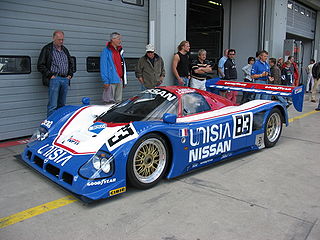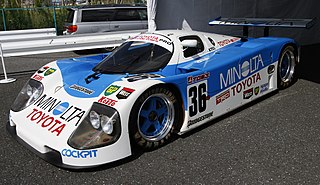
All American Racers is an American-licensed auto racing team and constructor based in Santa Ana, California. Founded by Dan Gurney and Carroll Shelby in 1964, All American Racers initially participated in American sports car and Champ Car races as well as international Formula One events with cars named Eagle. The Formula One team, based in the United Kingdom and using British-built Weslake engines was named Anglo American Racers. Under team manager Bill Dunne they set up shop in Rye, East Sussex. The team were adjacent to Harry Weslake's engine development plant and half a mile from Elva cars. They participated in 25 Grands Prix, entering a total of 34 cars.

Group C was a category of sports car racing introduced by the FIA in 1982 and continuing until 1993, with Group A for touring cars and Group B for GTs.

The Toyota TS010 was a Group C racing car built by Toyota for the Sportscar World Championship, All Japan Sports Prototype Championship, and the 24 Hours of Le Mans.

Dome Co. Ltd, literally "child's dream", is a Japanese racing car constructor involved mainly in open-wheel and sports car racing.

IMSA GT was a sports car racing series organized by International Motor Sports Association. Races took place primarily in the United States and occasionally in Canada.

SARD Corporation is a Japanese tuning company and racing team from Toyota, Aichi, mainly competing in the Super GT series and specializing in Toyota tuning parts.

The Nissan R90C was a platform used for Group C racing cars built in 1990 by Nissan Motors for competition in World Sportscar Championship (WSC) based in Europe and the All Japan Sports Prototype Championship (JSPC). The cars based on the basic R90C platform would compete until 1993 before Nissan chose to withdraw from sports car racing, not returning until 1997. It won three JSPC championships and several significant endurance races during its career.

The Eagle HF89 and its evolution, the Eagle HF90, is a racing car built and entered by Dan Gurney's All American Racers team, for the IMSA GT Championship. It was raced from 1989 until 1991 in IMSA's premier sports-car racing category, the GTP division. The design was also sometimes called the Eagle MkII.

The Toyota 88C-V was a Group C sports prototype entered by Toyota in 1988. The race car has a top speed of 375 km/h (233 mph), accelerates from 0–100 km/h (0–62 mph) in 3.8 seconds, produces 809 CV at 8000 rpm and weighs 850 kg (1,870 lb). It is the successor to the Toyota 88C and the predecessor to the Toyota 89C-V. Like other Toyota-powered sports prototypes of the era, it was designed and built by Dome. The car was a new design, developed around the Toyota's R32V 3.2 L (200 cu in) turbocharged V8 engine, which replaced the 88C's standard turbocharged Inline-4. The 88C-V competed in the All Japan Sports Prototype Championship.
Lars Eje Elgh is a Swedish racing driver and television reporter. He currently works as an expert commentator for Formula One in Sweden together with Janne Blomqvist. The two have worked together as Formula One commentators for a long time, first for TV4 and then for Viasat Motor when they took over the Formula One broadcasting in Sweden.

The Toyota 90C-V was a racing car built by Toyota, developed as a Group C1 car. It took part in the All Japan Sports Prototype Championship, the World Sportscar Championship, and at the 24 Hours of Le Mans.

The Eagle MkIII is a sports prototype racing car built by All American Racers in 1991 to IMSA GTP specifications. Powered by a turbocharged Toyota inline-4 engine, the car was campaigned in the IMSA Camel GT series by Dan Gurney's Toyota-sponsored AAR team from 1991 through to the end of 1993. The Eagle MkIII won 21 out of the 27 races in which it was entered and is considered one of the most successful and technologically advanced designs of the IMSA GTP era — "a car that proved so overwhelmingly dominant that the class for which it was created has now been assigned to history", according to Racer magazine.
The International Suzuka 500 km, was the opening round of the 1985 All Japan Endurance Championship, which was held at the Suzuka Circuit, on 7 April, in front of a crowd of approximately 23,000.
Drake Olson is an American former racing driver from Bridgewater, Connecticut.

The Suzuka 500 km, was the opening round of the 1987 All Japan Sports Prototype Championship was held at the Suzuka Circuit, on 12 April, in front of a crowd of approximately 18,000.
The TOM's Toyota LMP was a Le Mans Prototype built by Toyota. A very low budget effort, the car reused the 2.1-litre turbocharged straight-four engine from Toyota's Group C cars and was intended as an experimental car. It never raced, although it was tested on at least three occasions.

Le Mans Ltd., headquartered in Shibuya, Tokyo is an automobile parts manufacturer founded in 1967. The original company name was Le Mans Chamber of Commerce. The company is mainly engaged in the development and sales of motorsport parts and the import and sale of race cars overseas.

The Toyota R32V and R36V engine family are a series of turbocharged, 3.2-liter and 3.6-liter, 90-degree, four-stroke, V-8, gasoline racing engines, designed, developed and produced by Toyota for sports car racing; between 1988 and 1999. The engines were used in various Toyota sports prototype race cars.

The Toyota 87C, also known as the TOM'S 87C, was a Group C prototype sports car, designed, developed and built by Toyota, for use in sports car racing, specifically the World Sportscar Championship, between 1987 and 1988.

The Toyota 89C-V is a Group C sports prototype racing car, developed and built by Toyota intended to participate in the World Sportscar Championship, the 24 Hours of Le Mans, and the All-Japan Japanese Sports-Prototype Championship. The chassis is designed by Japanese company Dome. It is powered by a turbocharged 3.2 L (200 cu in) Toyota R32 V8 engine, producing 800 hp (600 kW). It won 2 races, scored 4 podium finishes, and clinched 3 pole positions.
















